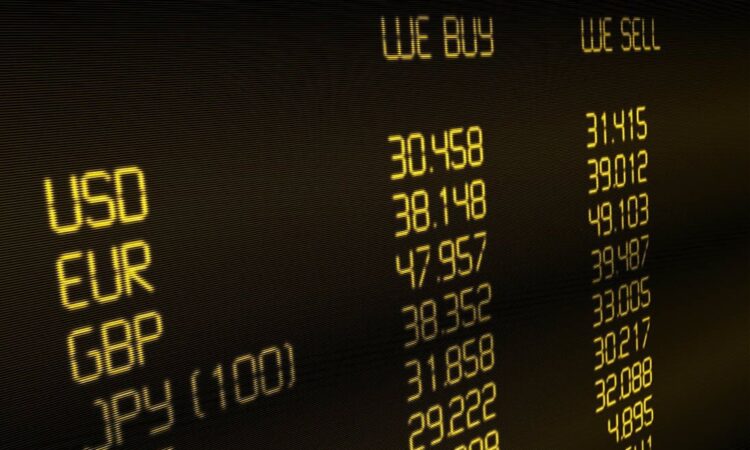
“We think the data clearly point to upside risks to growth; however, our broader view of a European recession remains in place” – Barclays.

Image © Adobe Images
The Pound to Dollar exchange rate fell further in the final session of the week to round off what was a bruising period for Sterling and many other currencies but it also appeared to be stabilising above its nearby 200-day moving-average ahead of the weekend.
U.S. Dollars were bought almost across the board on Friday amid further heavy losses for stock and bond markets but the Pound-Dollar rate appeared to find its feet somewhat S&P Global PMI surveys suggested that an earlier downturn in the U.S. manufacturing and services sectors deepened in December.
Larger-than-expected declines for both sectors came in contrast to better-than-expected numbers from some parts of Europe where the French and German indices bounced far enough to be left sitting above those of the U.S. in both sets of industries.
“Jobs growth has meanwhile slowed to a crawl as firms across both manufacturing and services take a much more cautious approach to hiring amid the slump in customer demand,” says Chris Williamson, chief business economist at S&P Global.
Friday’s PMI surveys were the ninth set this year to surprise on the downside of expectations in the U.S. and came at the tailend of a week in which the Federal Reserve raised interest rates to 4.5% this week and warned that they could rise as far as 5.5% next year.
 Above: Pound to Dollar rate shown at two hour intervals with Fibonacci retracements of early November rally indicating possible areas of technical support.
Above: Pound to Dollar rate shown at two hour intervals with Fibonacci retracements of early November rally indicating possible areas of technical support.
Equivalent surveys also suggested on Friday that recessions in the UK manufacturing and services sectors moderated in December.
“We think the data clearly point to upside risks to growth; however, our broader view of a European recession remains in place,” says Abbas Khan, an economist at Barclays.
While the Pound to Dollar rate appeared to be stabilising late on Friday it remained lower for the week with notable losses having been sustained in the wake of Thursday’s interest rate decisions from the Bank of England and European Central Bank.
The BoE raised Bank Rate by half a percentage point to 3.5% in the ninth increase since last December but not all on the Monetary Policy Committee (MPC) agreed with the decision due to a three-way split of views about how quickly inflation could be expected to fall next year.
“With the BoE the first major central bank to raise rates it may be the first to end its cycle too (we expect in March),” says Jordan Rochester, a strategist at Nomura.
“If markets continue to witness a bounce in growth data it might offset the near-term doom and gloom. But the UK may also see a significant rise in defaults too and this may perhaps play a role in the global canary in the coal mine,” Rochester writes in a Friday research briefing.
Above: Sterling performance relative to major currencies Friday on the left and for the week overall on the right. Source: Pound Sterling Live. To optimise the timing of international payments you could consider setting a free FX rate alert here.
Two members of the BoE’s nine seat rate setting committee voted for no change at all this week while one member voted for a larger increase with losses for Sterling following on from the decision though it was the ECB who stole the show with the greatest imact on markets.
The ECB raised its rates for a fourth time since July, lifting its once negative deposit rate from -0.5% to 2.5% over that period, while it warned this week that it intends to raise rates significantly” further once into the new year.
In addition the bank also said intends to begin the process of reversing its quantitative easing, which had previously driven large amounts of capital out of the Eurozone and into other markets including those for stocks and bonds.
This as much as anything else could be why the Euro fared better than the Pound and many other currencies over the course of the week.
“The ECB is posturing very hawkish straight into a growth slowdown. Similar to the US Fed but the US economy likely has more resiliency. This is why EUR couldn’t hold its gains,” says Brad Bechtel, global head of FX at Jefferies.
“The real mover was in EUR/GBP as the BoE sounded as dovish as ever. Here is a central bank that is clearly trying to under shoot what the market prices and delivers on the dovish side nearly every time. The market appears to have received the message this time,” Bechtel writes in a Friday market commentary.
 Above: Pound to Dollar rate shown at daily intervals with Fibonacci retracements of early November rally and 200-day moving-average indicating possible areas of technical support. If you are looking to protect or boost your international payment budget you could consider securing today’s rate for use in the future, or set an order for your ideal rate when it is achieved, more information can be found here.
Above: Pound to Dollar rate shown at daily intervals with Fibonacci retracements of early November rally and 200-day moving-average indicating possible areas of technical support. If you are looking to protect or boost your international payment budget you could consider securing today’s rate for use in the future, or set an order for your ideal rate when it is achieved, more information can be found here.






